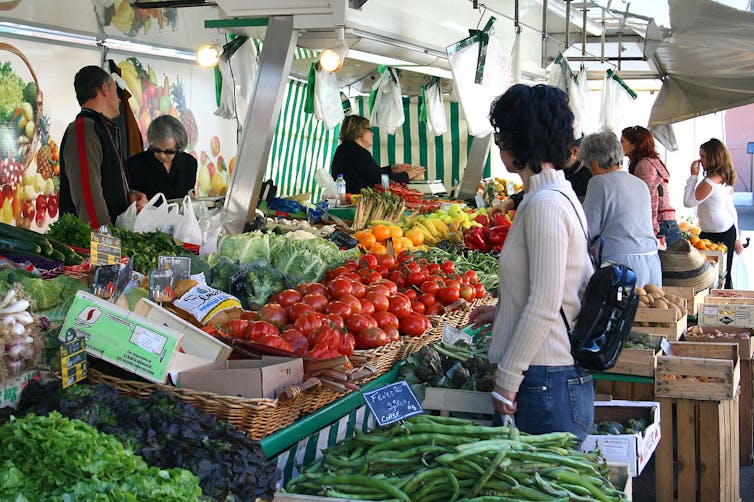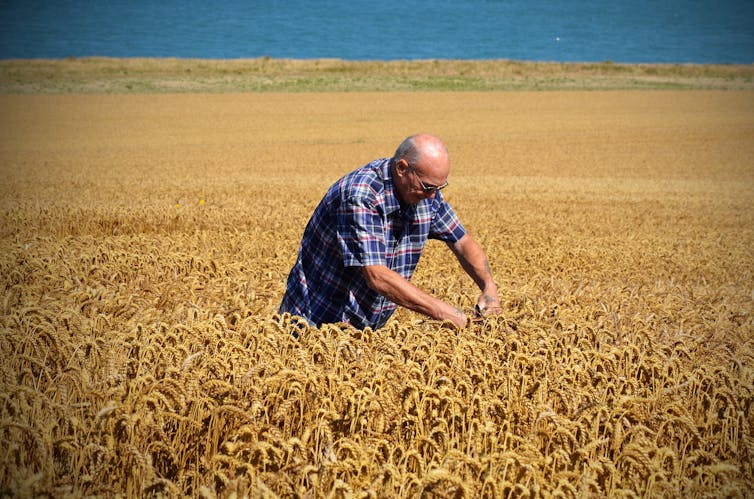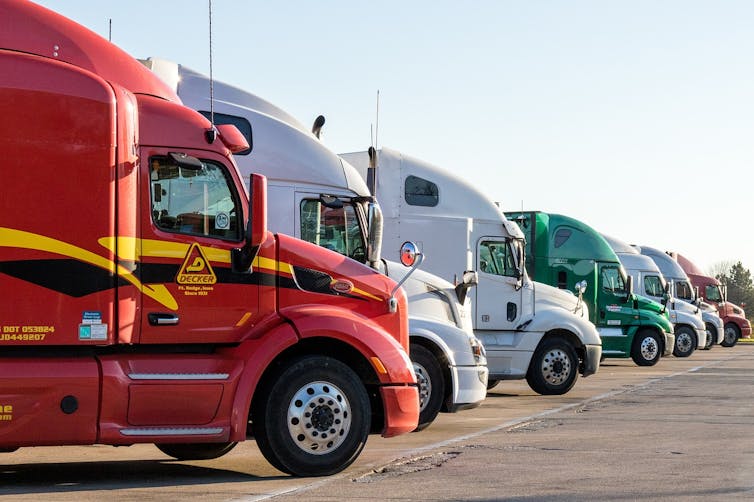To republish this article
Read theoriginal article in english and consult terms of republication.
Food: are short food supply chains always sustainable?
By Thomas Zeroual, ESCE International Business School, Amélie Gonçalves, Frédéric Wallet, Inrae Université Paris Saclay and Gwenaelle Raton, SPLOTT, Université Gustave Eiffel

The current context favours the development of short food supply chains. While the post-lockdown period was partly accompanied by a return to old ways, the Coronavirus crises sparked a renewed interest in local food and direct sales to consumers.
This interest can be explained by the reassuring image of local farm produce, which is considered healthier, and by consumers’ desire to avoid crowded places and prioritise local commerce for health reasons.
This favourable context was accompanied by an underlying trend linked to the reputation of short food supply chains, which are considered more virtuous than other supply chains from an economic, social and environmental point of view.
Reducing the number of intermediaries and shortening distances are perceived as solutions to environmental requirements (reducing distances travelled and therefore greenhouse gas emissions) and economic and social demands (better profit distribution along the value chain, proximity of relationships with a positive impact on agricultural practices and farmers’ satisfaction with their work). The sustainability of short food supply chains seems to be a strong argument for their development.
However, the reality does not always live up to expectations. We carried out a qualitative survey among 16 contributors to short food supply chains and the results – which are corroborated by other studies – show that the sustainability of these channels depends on two main factors.
More work for the farmer
From an economic point of view, having a smaller number of intermediaries can theoretically increase the farmer's margin. Many studies have shown that these circuits often allow farmers to stabilise or even increase their income. Consumers also say they are prepared to pay more for local produce.

However, this can also mean extra work. Marketing their produce is not always easy for farmers. It requires considerable resources, such as additional time or more labour-intensive practices, as well as the necessary equipment. Short food supply chains may even prove unprofitable in terms of the work involved.
Reducing the number of intermediaries does not necessarily simplify channels, but transfers much of the workload to the first link in the chain, i.e. the farmer.
Besides the core business (farming), additional work must be done for logistics and transport (delivering, packaging, taking and preparing orders) and marketing, which are not always farmers’ key skills and are time-consuming and often costly in terms of resources and manpower.
More contributors, more journeys
Short food supply chains are not defined only by the number of intermediaries. The geographical criterion can be added. The geographic scale can vary from a few dozen kilometres to several hundred kilometres, depending on the type of product. Although these circuits are associated with the concept of “local” or “proximity”, there is no consensus on the maximum distances they involve.
The distances travelled by products have been increasing since the 1970s and reducing this distance is an issue that seems to lead de facto to less environmental impact.
However, this causality is more complex than it appears.
Firstly, two thirds of the carbon footprint of food in France is linked to production, with transport accounting for 19% of greenhouse gas emissions, including the transport of goods and consumer journeys. The question of reducing and optimising transport is therefore pertinent, but the mode of production is also an important factor in the environmental footprint of a food distribution channel.

Secondly, in terms of tonne-kilometres, the most local supply chains are not necessarily the least polluting. These channels have specific logistics requirements in terms of the flows and the profile of those who create them.
Flows are fragmented into small volumes. They are generated by many different farms and are destined for a multitude of sales outlets. This fragmentation makes it impossible to benefit from massification and leads to multiple journeys with small loads. However, it remains to be seen whether the products transported are comparable, particularly in terms of nutrition, and therefore whether the tonne-kilometre indicator is the most relevant.
Thirdly, these flows are generally not managed by professionals, but by farmers or employees of collective organisations who have little expertise in supply chains (they are most often trained on the job) and few resources to implement them, i.e. little investment capacity or ability to pay for services.
Lastly, not benefiting from the massification and professionalisation of logistics also means missing out on tools for optimising flows: the communication and traceability standards used in long distribution channels (EDI (electronic data interchange), RFID (Radio Frequency Identification), barcodes, etc.) are poorly suited and too costly. The same applies to transport packing standards (crates, cartons, etc.).
The benefits of improving supply chains
Although long chains are often criticised, for example for the precarious working conditions, they are nonetheless efficient from a logistical point of view. They supply the right product, at the right time, in the right place, in the right quantities and at controlled cost.
This efficiency is based on the professionalisation of supply chain jobs, the development of tools, protocols and standards shared by as many people as possible, and the consolidation of flows, i.e. grouping them together in order to increase the volumes transported and achieve economies of scale.
Short food supply chains have a good reputation; but scientific research shows that the benefits are not systematic. It is harder to improve supply chains and reduce their cost for short- than for long-distance distribution.
Finally, the short and local food supply chains are not just those of long distribution channels on a smaller scale, but they have their own specific room for manoeuvre and their own constraints. The challenge now is therefore to strike a balance between the optimisation of load rates, farm profitability, environmental impact, the development of new practices (returnable items, use of bulk, etc.) and changes in relations between producers and consumers.
Identity card of the article
| Original title: | Alimentaire : circuits courts, une durabilité sous conditions |
| Authors: | Thomas Zeroual, Amélie Gonçalves, Frédéric Wallet and Gwenaelle Raton |
| Publisher: | The Conversation France |
| Collection: | The Conversation France |
| License: | The original version of the article was published in French by The Conversation France under Creative Commons license. See the original article. An English version was created by Hancock & Hutton for Université Gustave Eiffel and was published by Reflexscience under the same license. |
| Date: | July 10th, 2023 |
| Langages: | French and english |
| Keywords: | Trade, sustainable development, pollution, feeding, international trade, consumers, short circuits, emission reduction, production, sustainable consumption, green economy |
![[Translate to English:] Consultez le site web The Conversation France](https://reflexscience.univ-gustave-eiffel.fr/fileadmin/_processed_/7/c/csm_TC_Stacked-ENG-FR_d13cf8099d.png)
![[Translate to English:] Licence creative commons BY-SA 4.0 [Translate to English:] Licence creative commons BY-SA 4.0](https://reflexscience.univ-gustave-eiffel.fr/fileadmin/ReflexScience/Accueil/Logos/CCbySA.png)